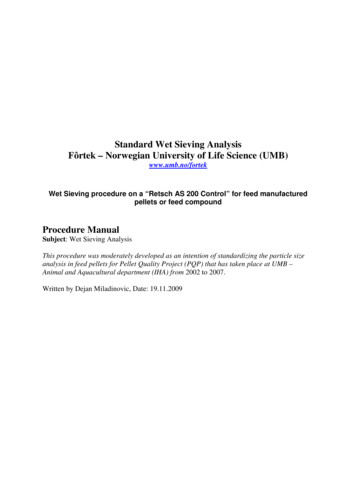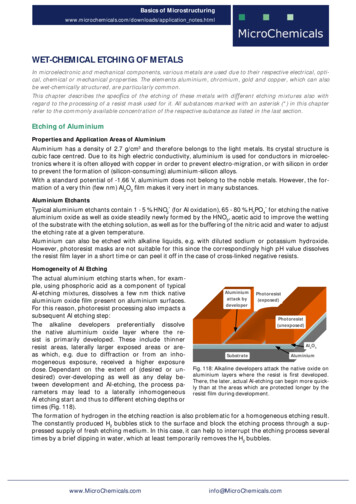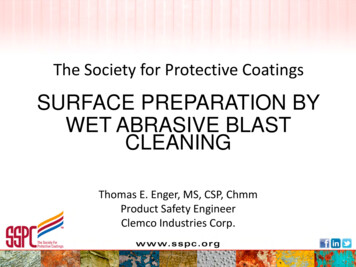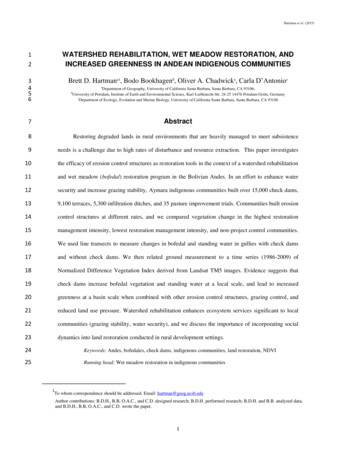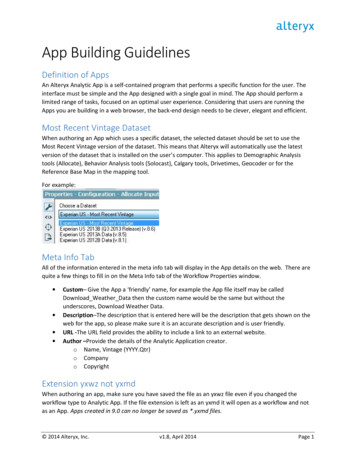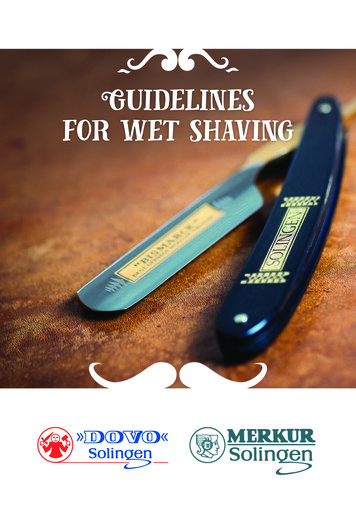
Transcription
Guidelinesfor wet shaving
The Straight razorAPRODUCTION,MAINTENANCE AND USEt first, a little bit of technical qualification on execution andproduction of a straight razor which consists of a blade with tang and2 scales (handles). Contrary to regular knives, the straight razor hasa hollow grinding, which – depending on the thickness – will bediscerned as flat ground, half or three quarter hollow ground, orfull hollow ground (see sketch page 4). In these increments,quality and price of the straight razor in the blade widths from3/8" to 6/8" are reflected.The most common are straight razors in 5/8" ( 16.25 mm).Due to the limited conditioning possibilities in the 17thcentury, flat ground blades are amongst the primary bladeshapes. They were mainly in use for medical purposesas scalpels, later on also for a full or contour shave.Flat ground straight razors of 2/8" width are suitablefor the cosmetic shave of eyebrows. Nowadays,hairdressing salons use such straight razors of3/8" width for thinning of hair (over a comb).Flat ground straight razors are also used forpre-surgery shaves in hospitals. Half or fullhollow ground straight razors, preferably inthe widths 5/8" and 6/8", meet the requirements for a thorough and deep shave inthe entire area of cheek, upper lip, chinand neck through their flexibility.QUALITY FROM SOLINGENMADE IN GERMANY2And hisbestFriendOlive wood,pure badger918 1063
Ebony with gold colourNFull hollow ground2 6810 6 8"CThe Straight razorSHAPE AND STEELustomarily, flat ground straight razors are offered nowadays with a so-calledFrench point, whereas half or full hollow ground straight razors come with a roundpoint, very rarely with a square point. In addition, hollow ground blades have adouble stabilizing piece for additional stability (cp. sketch page 5), which builds thetransition from tang to blade. Full hollow ground blades especially, with their thinnestpart being located between the spine and the ridge (see sketch below) combine majorflexibility with major longitudinal torsional stiffness. The coaction of the shape andthe fine cutting edge produce a thorough wet shave with a straight razor.Specialties, such as square point and concave mirror, are regional shapes.Mild steel with a carbon content of 1 % and more is considered the basic material forthe classic straight razor, which will achieve maximum possible hardness, elasticityand wear resistance with a meticulous tempering treatment. The advantages of thestainless steel qualities are in the lesser maintenance requirements. Nevertheless,rusting cannot be excluded, depending on water quality and care. Stainless chromiumsteel used to be favored primarily by barber shops. With today’s hygiene standards,razors with exchangeable blades like the »DOVO« Shavette are now in use.Gold etchingBackDouble stabilizing pieceTrademarkPointPoint shapes:Round pointTangCross-sections of razors – Degree of hollowness:Hollow groundCutting edgeDecorated tangFrench pointSquare pointInlayFlat ground4Full hollowgroundHandle½ Hollowground5
ProductionTHIS IS HOW WE DO ITWorks in the smithy and the hardening plantThe early blank consists of a piece of steel with a 10 mm diameter.The red hot cropped piece is hot formed with high pressure in a forgingdie under a drop hammer. The excess edge (wing) is cut off in thestamping tool, and the hole for the pin is drilled.The tempering (hardening and tempering) of the blanks is ofimportance, which are heated to 810 C or 1040 C depending of thesteel type, and is quenched in a special oil afterwards.The temperature limits are often defining, and sometimes also theprofessional secret of the experienced hardener. The followingtempering at approx. 200 C provides the blade with elasticity anddurability. Constant controls of the hardness according to Rockwell(HRC) guarantee sharpness and the sustainment of the cutting edge.ITortoise shell imitationNFull hollow ground1516 580 5 8"6Hollow Grinding and Joining of Blade and Handlen approx. 15 work steps the hollowgrinding takes place on special machineswhere the diameter of the grinding stone isimportant for the desired hollowness.Following that, the tang and spine areground, afterwards the fine grinding of thehollow, the wall and the grind is executed.The cutting edge (grind) is ground by handto the thickness of a razor blade (0.1 mm).During the concluding fine grinding aconsistent, color reflecting matt finish isachieved. The engraver’s subsequent workdecorates the blade with laser engravingsand gold applications.For the galvanic coating thorough handcleaning and painting with asphalt varnishis mandatory.With a German silver pin the two handlescales made of waterproof hardwood, cowhorn or acrylic (tortoise and pearlimitations) are mounted, so that the bladecan be folded into the middle.All straight razors are being sharpened,stropped and checked during a 5 hourprocess by experienced employees. Finalpolishing of the handle, as well as cleaning,oiling, and packaging of the razor finish offthe production process.7
HornWNFull hollow ground3 580 5 8"fter using it, the straight razor must be rinsed off – preferably with clear, hot water –and thoroughly dried off (without touching the blade with naked fingers). During extendedstorage it is recommended to oil the blade with a highly fluid oil which is free of acid andresin. The razor should be stored in a dry and well-aired environment. It is important to alsoclean the handle inside and out of any soap residue, and to also dry the handles on boththe outside and inside and all the hard to reach places (such as the area where the blade ismounted which is often overlooked). The razor should only be stored when thoroughly dried.Fingerprints, acids from cleaning agents, and chlorinated water will quickly tarnish mild steel(incipient rust). Disinfectants are equally damaging for steel and handle.For the stropping of the razor there are two important rules: always strop PRIOR TO THESHAVE, and between 2 shaves the blade should rest for a minimum of 48 hours (better yet:several days). Wet shavers of the old school know: “the cutting edge grows” which means thatthe wafer-thin ridge (visible under the microscope) looks like the teeth of a comb. The ridgebends because of the cutting performance during the shave, but will return to its old positiondue to its elasticity, and regain its wafer-thin ridge.Therefore it can be sufficient in some cases to whet the razor over the heel of hand PRIOR TOTHE SHAVE. The fine ridge dissipates again, and then the razor strop that should be boughtwith the razor must be used, prepared with the fatty paste.8MaintenanceAMaintenance of the Straight RazorStrop and Stroppinghile the wedge shaped straight razor is pushedagainst a handheld strop, a classic hanging strop made offine, vegetable-tanned calf leather, is used for half or fullhollow ground razors. The hanging strop features a swivelgrommet for hanging, and some of them also come with acanvas strap on the backside. The canvas side is for stropping the blade with pulverized dolomite. For the leatherside we recommend our fine leather balm (fatty paste)without sharpening properties. The leather balm shouldbe thinly applied by heel of hand or with a cotton cloth,then polished with the cloth. The blade must not stick tothe fatty layer on the strop surface. The leather must beclean and undamaged. Fine metal splinters that came offthe blade during the stropping will damage the blade andpoint to a broken off ridge. In that case the razor needsto be re-sharpened. Other razors will also be damaged ifstropped on the corrupted strop.The stropping is executed by applying the cutting edgeand the spine of the razor simultaneously onto thetightened strop which provides the angle. The blade mustonly be PULLED in the direction of the spine - carefully,without pressure, but with constant contact with theleather surface. The blade must only be turned over thespine (see sketch) and the pulled into the other direction. Turning it over the cutting edge with destroy theridge, and then only grinding by a professional will help!9
The ShaveTHIS IS HOW YOU DO ITArazor maintained in such a way is not prepared for an experientialshave. A thorough shave starts with soaking the whiskers, for exampleduring a shower or by applying a wet, warm washcloth.The novice will at first start with the unproblematic, even zones of the face and will holdthe open straight razor with thumb and three fingers in a way that the open scales pointaway from the face (see sketch)With the lather – preferably from shaving soaps with a high glycerincontent – you will soften up the whiskers with massaging brushsweeps for a few minutes and let them swell.The shave commences with the grain, very light pressure and constant contact of theridge with the soaped-up skin, solely with first third of the ridge from the tip.In an angle of approx. 30 towards the surface of the skin the blade is guided instraight, short strokes across the skin. At the same time, the skin is stretched tight with thesecond hand, which is always following the razor spine. With that, the whiskers are alwaysstood up optimally, and a “running away” of the skin can be avoided. An evenly scratchingsound develops.If the angle is too flat, the razor will drag the stubble, if the angle is too steep, therazor cuts into the skin, or moves over the stubble without any shaving effect. It is important to always move the blade vertically scratching in the direction of the cutting edge,never turn or pull (risk of injury!), always scratch evenly, and hold the razor a bit steeper atcorners, dimples und upper lip. If necessary, give the shave a second go against the grain.30 Dropping the razor onto a hard surface, or the edge coming into contact with the scales,usually renders the razor unusable. Therefore it is important that blade is fitted carefullyinto the gap between the scales when it is folded together. The scales can warp withtemperature! If the edge is damaged, mere stropping won’t do, but only a proper regrindund stropping executed by a skilled worker. Please ask your retailer or »DOVO« directly forthe repair flat rate.right1011
Trivia aboutI»DOVO« SHAVETTE n the age of extensive sanitation standards, there is a limit to the use of a straightrazor at a barber shop. In some cases it is possible to be given a shave after priorconsultation, if you bring your own straight razor.The clean solution is a straight razor with an exchangeable blade, the »DOVO« Shavette .This razor, made of stainless steel or aluminum, is a barber’s professional tool.The classic double-edge razor blade will be broken in half lengthwise along the middle,and installed in a plastic blade holder. For each new face always clean and sharp.Due to their lower price, the »DOVO« Shavette is also suitable for novices. Preparationfor the shave, handling and blade guidance is the same as for the straight razor, and thesharpness can be renewed quickly if necessary. With constant application, the fine edgemust be considered here as well, with a maximum of one shave per day.GuidelinesFOR MERKUR SAFETY RAZORSWTypes of Razorshen the one-way blade was introduced at the beginning of the 20th century,several types of safety razors already existed. The standard version is the straight closedcomb. Razors with an open tooth combs are meant for the removal of longer beards orbody hair. The teeth allow for long hair to get through to the blade, which the closedcomb would hold down.One distinguishes between two configurations: The three-piece razor consisting of a topplate, comb and handle, and the two-piece razor consisting of top plate and comb withneck, handle and rotatable key.The slanted razor serves to stabilize very thin blades (0.08 mm) that wereavailable in the past. An additional effect of the slanted blade is the tendencyof the movement in the direction of the blade. This is not hazard-free, butsuitable for a very strong beard.Aluminium black,Handle: Olive woodThe mechanically most complex type is the adjustable razor.The blade gap adjustment with setting scalevaries the distance between the blade and theskin-stretching comb. The system allows theadjustment of the razor for an individualshave feeling from soft to strong.90 15 001201 0711213
MTip:The badger hair shaving brushtolerates the alkaline shavingsoap only, if it is thoroughlyrinsed daily, and degreasedoccasionally. Otherwise, the hairwill break off (shedding!) andthe brush head disintegrates.Materials, Maintenanceost of the MERKUR razors are made of die-casted zinc(top plate, comb) and brass handles. The surfaces are galvanically coated in three layers (copper, nickel, chrome).The model series FUTUR is entirely made of die-casted zinc,with the surface options of matt chrome, glossy chrome,and glossy gold.Throughout the world, tab water is unfortunately more orless limy, and to some extent, chlorinated. In combinationwith the often very fatty shaving soaps, the durability ofthe razor suffers from the contact with those mediums,and the danger of material corrosion increases. Regularmaintenance with a soft brush and the occasional degreasing with hair shampoo or dishwashing liquid prolongs thelifespan of the metal razors, and removes matt spots.APreparation of the ShaveHandlingWith the beginning of the 20th century, safety razors with a classic double-edge bladebecame the successors of the straight razors for everyday use. The shave is thorough, and handling of the open edge requires a bit of skill and practice, but can be acquired quickly. The safetyrazor shave is executed with planning, scratching movements vertically towards the cuttingedge. Movements in the longitudinal direction of the blade, or turns, can lead to injuries. Thelather edge of the comb serves to stretch the skin tight, so all whiskers are reached. The razor’sown weight facilitates the gliding without pressure for a gentle shave. As with a straight razor,it is idea
never turn or pull (risk of injury!), always scratch evenly, and hold the razor a bit steeper at corners, dimples und upper lip. If necessary, give the shave a second go against the grain. Dropping the razor onto a hard surface, or the edge coming into contact with the scales, usually renders the razor unusable. Therefore it is important that blade is fitted carefully

